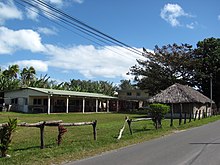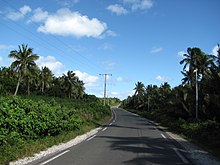Ouvéa
| Ouvéa | |
|---|---|

|
|
| province | Loyalty Islands |
| Aire coutumière | Iaai |
| Coordinates | 20 ° 39 ′ S , 166 ° 34 ′ E |
| height | 0-46 m |
| surface | 132.10 km 2 |
| Residents | 3,374 (August 26, 2014) |
| Population density | 26 inhabitants / km 2 |
| Post Code | 98814 |
| INSEE code | 98820 |
 Ouvéa beach |
|
Ouvéa is an atoll that belongs to the Loyalty Islands east of New Caledonia in the Pacific Ocean .
geography
Ouvéa is an upscale atoll , with only the eastern edge raised and steep cliffs up to 46 meters high on the east side. This consists essentially of the main island and by far the largest island Ouvéa, as well as three other islands, which together with Ouvéa form an almost closed land arc on the east side of the atoll, with an arc length of more than 50 km. These are Unyee in the north and Faiava (Fayawa, Wasau) and Mouli in the south. These smaller islands are only separated from the main island by narrow passages that are only suitable for small boats.
The main island stretches for 37 km from north to south, taking into account the arc that protrudes to the east for 42 km. It is a maximum of 7.7 km wide in the north. In the middle, however, it narrows to 420 meters by the Baie de Fayaoue on the windward side and can therefore be described as a double island .
The north side of the atoll is formed by about 18 small islands, which extend over 30 km west of Unyee and which are known as Pléiades du Nord or Motu Oo Weneki. The largest island in this chain is Angeü (Degouala, Île Agnéhu).
On the southwest side of the atoll are the Pléiades du Sud or Motu Oo Muli, about nine islands that extend over around 25 km. The largest island in the Pléiades du Sud is Bagaat (Long Island) in the west of the chain.
The Pléiades du Nord and Pléiades du Sud converge on the open west side of the atoll, where the five-kilometer-wide Passe d 'Anémata (Ngutu Kaiava Efa) is located, the largest passage into the lagoon.
A very small cay with no vegetation (Oüdetr or Uadi) is located south of the Pléiades du Nord, 1.7 km southeast of Motu Veolia, within the lagoon . The lagoon has an area of 850 km² and is a maximum of 44 meters deep. The total area of the atoll is 1050 km².
| Eastern main island arc from north to south |
lagoon |
|---|---|
|
|
| Pléiades du Nord (Motu Oo Weneki) from east to west |
Pléiades du Sud (Motu Oo Muli) from southeast to northwest |
|---|---|
|
|
administration
Ouvéa forms with the small uninhabited neighboring atoll Beautemps-Beaupré-Atoll (15 kilometers northwest) the French commune of the same name in New Caledonia . The municipality has 3392 inhabitants (2009) on an area of 132.1 km². In Wadrilla , the capital of the island, is the seat of the local government ( Mairie ). Originally Fayaoué was the island's administrative center. Today the police station ( gendarmerie ) is located in Fayaoué .
Traditional outline

Ouvéa is traditionally divided into five districts coutumiers ( chiefdoms ):
| District | Residents 1996 |
location |
|---|---|---|
| Fayaoué | 1975 | central, contains wadrilla |
| Mouli | 640 | Southwest, Faiava, Mouli |
| Imone | 247 | Northeast |
| Saint Joseph | 777 | Northeast / Northwest, and Beautemps-Beaupré-Atoll |
| Takedji | 205 | middle north |
| Ouvéa | 3844 |
history
In 1988, there was a hostage-taking on Ouvéa, with 27 policemen and a judge detained in a cave by separatists for several days. A memorial in Wadrilla commemorates the 19 separatists who were killed during the liberation of the hostages.
economy
3000 hectares of the main island Ouvéa are covered by coconut plantations, which are a not inconsiderable economic factor. Ropes are made from coconut fibers on Ouvéa, and coconut oil and soap are made in a distillery at the ferry terminal north of Wadrilla. Vanilla is grown in the village of Saint Paul near Fayaoué. The plantation and the Vanilleraie , where various products are made from vanilla, can be visited.
Ouvéa has opened up to sustainable tourism in the form of smaller guest houses and tent sites, with guests being accommodated in huts that are built in traditional style. The price level is higher than on the main island of New Caledonia and the neighboring islands.
Apart from the coconut plantations, agriculture is of little importance on Ouvéa as the soil is sandy and not too fertile. In addition to coconut palms, bananas are most likely to thrive on crops. Until the seawater desalination plant was completed in 1994, fresh water was scarce on Ouvéa. No fields or arable land were created. Cattle breeding is also of secondary importance, with only a few cows on Ouvéa. Fishing is only done in small boats for personal use.
traffic
The ferry terminal is about 5 km north of Wadrilla. From the island's airport, which is 6 km east of Fayaoué, there is a twice daily flight connection to Nouméa . There is no public transport on Ouvéa, but the accommodation providers can arrange shuttle services to the airport or island tours. Rental cars and some taxis are also available. The road network on Ouvéa is well developed and paved. However, most of the houses are not located directly on the asphalt roads, but on smaller, undeveloped access roads that branch off from them. Street names or house numbers are not available.
languages
The native languages are Iaai and Faga Uvea .
Attractions
Ouvéa is a popular tourist destination because of its 25 km long sandy beach that stretches from Mouli in the south to Anawa in the north. In the south of the island of Ouvéa, near the village of Lékiny, the cliffs of Falaises de Lékiny with its caves are worth a visit. The Trou Bleu d'Anawa lake on the edge of the village of Anawa has an underground tributary from the sea. Sea turtles live in the lake, whose name means "Blue Hole of Anawa" and which is 30 m deep with a diameter of 30 m.
Apart from the natural beauties of Ouvéa, various monuments and churches that bear witness to the unbroken, pronounced religiosity of the locals are worth visiting.
The churches, made of stone or coral limestone, are visible from afar and form a striking contrast to the traditional architecture of flat, single-storey houses. The Catholic Church in Fayaoué, the main town of Ouvéas, with its two towers and the red corrugated iron roof was built in 1903. In front of the Protestant church in Fayaoué, a memorial in several languages commemorates the centenary of the Protestant mission (1856–1956). In Mouli in the south of Ouvéa, the Catholic church from 1896 rises at the end of an avenue of araucarias , next to the church there is a Marian shrine, which is reminiscent of the Lourdes grotto .
In Banoutr in the middle of Ouvéa, a new Protestant church is under construction, near which there is still the too small chapel in the traditional architectural style: the walls and roof are woven from palm leaves.
map
Individual evidence
- ↑ oceandots.com ( Memento from December 23, 2010 in the Internet Archive )
- ↑ http://www.sil.si.edu/digitalcollections/atollresearchbulletin/issues/00452.pdf (PDF; 725 kB)
- ↑ ftp://rock.geosociety.org/pub/reposit/2001/2001075.pdf
- ↑ Pierre Grundmann: Nouvelle Calédonie , p. 238, Paris 2012
- ↑ Archived copy ( memento of the original from March 10, 2012 in the Internet Archive ) Info: The archive link was inserted automatically and has not yet been checked. Please check the original and archive link according to the instructions and then remove this notice. (PDF; 158 kB)
- ↑ Mike Hosken: Au Coeur du Caillou , p. 321, Nouméa 2011
- ↑ Mike Hosken: Au Coeur du Caillou , p. 317, Nouméa 2011
- ↑ Mike Hosken: Au Coeur du Caillou , p. 326, Nouméa 2011
- ↑ http://www.isee.nc/tec/atlas/telechserielongue/04-specificites.xls
- ↑ a b Pierre Grundmann: Nouvelle Calédonie , p. 199, Paris 2012
- ↑ Jocelyn Harewood. Nanuatu and New Caledonia , p. 178. Lonely Planet Pty Ltd. 2009
- ^ Pierre Grundmann: Nouvelle Calédonie , p. 198, Paris 2012
literature
- Jean Guiart: L'Organisation Sociale et Politiqueante traditional a Uvea (Iles Loyalty) online (PDF; 1.3 MB)
- Michel KULBICKI, Sebastien DUPON, Cécile DUPOUY. Georges BARGIBANT, Pascal HAMEL, Jean Louis MENOU, Gérard MOU THAM, Philippe TIRARD: Caracteristiques Physiqes du Lagon d'Ouvéa online (PDF; 3.5 MB)





